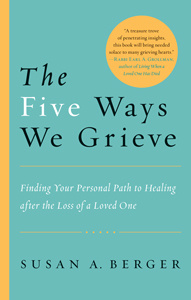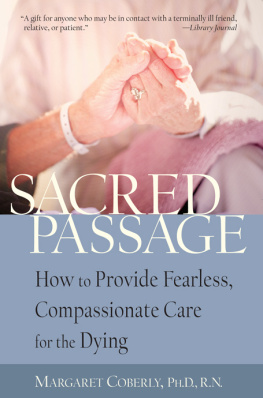A moving meditation on palliative care.... A supremely readable book that will attract readers of all faiths who will appreciate her clarity and compassion and the poignancy of these stories of ordinary people facing their final hours with quiet courage.
Publishers Weekly
This compelling, brave, and wise book draws from a lifetime of remarkable work with people at the end of life.
Andrew Weil, MD
Joan Halifax has a knack for straight talk and sublime insighta no-holds-barred approach to lifes greatest challenge, dying well. This book beckons to those who dare, and those who care; its a profound and practical guidebook to the inevitable final dance.
Daniel Goleman, author of Emotional Intelligence
This book is a gift of wisdom and practical guidance for living.
Ira Byock, MD, author of Dying Well and The Four Things That Matter Most
ABOUT THE BOOK
The Buddhist approach to death can be of great benefit to people of all backgroundsas has been demonstrated time and again in Joan Halifaxs decades of work with the dying and their caregivers. Inspired by traditional Buddhist teachings, her work is a source of wisdom for all those who are charged with a dying persons care, facing their own death, or wishing to explore and contemplate the transformative power of the dying process. Her teachings affirm that we can open and contact our inner strength, and that we can help others who are suffering to do the same.
JOAN HALIFAX, PhD, is a Zen priest and anthropologist who has served on the faculty of Columbia University and the University of Miami School of Medicine. For the past thirty years she has worked with dying people and has lectured on the subject of death and dying at Harvard Divinity School, Harvard Medical School, Georgetown Medical School, and many other academic institutions. In 1990, she founded Upaya Zen Center, a Buddhist study and social action center in Santa Fe, New Mexico. In 1994, she founded the Project on Being with Dying, which has trained hundreds of healthcare professionals in the contemplative care of dying people.
Sign up to learn more about our books and receive special offers from Shambhala Publications.

Or visit us online to sign up at shambhala.com/eshambhala.

CULTIVATING COMPASSION AND FEARLESSNESS IN THE PRESENCE OF DEATH
Joan Halifax
Foreword by Ira Byock, MD

SHAMBHALA
BOSTON
2011
Shambhala Publications, Inc.
Horticultural Hall
300 Massachusetts Avenue
Boston, Massachusetts 02115
www.shambhala.com
2008 by Joan Halifax
All rights reserved. No part of this book may be reproduced in any form or by any means, electronic or mechanical, including photocopying, recording, or by any information storage and retrieval system, without permission in writing from the publisher.
The Library of Congress catalogues the hardcover edition of this book as follows:
Halifax, Joan.
Being with dying: cultivating compassion and fearlessness in the presence of death / Joan Halifax; foreword by Ira Byock.
p. cm.
eISBN 978-0-8348-2174-3
ISBN 978-1-57062-469-8 (hardcover: alk. paper)
ISBN 978-1-59030-718-2 (paperback: alk. paper)
1. Terminal care. 2. DeathPsychological aspects. I. Title.
R726.8.H35 2008
616.029dc22
2007042003
To Francisco Varela
(19462001)
In death, you are going to be what your experience is.
B EING WITH DYING is a phrase that aptly describes the human condition. We may be unique among species in being aware of our mortality. Although the capacity to contemplate death is an essential human trait, most people actively eschew thinking about how their life might end.
While the dominant orientation of Western culture toward death is avoidance, for over 2,500 years Buddhists have studied the question of how one can best live in the presence of death. In a sense, a life-threatening injury or disease makes Buddhists of us all, waking us from the illusion of immortality, suddenly and from that time forth. From the moment of diagnosis, death becomes the bell that wont stop ringing. Like a dreaded phone call, we can try to avoid it, but the noise is always there. We can distract ourselves with medical information and frenetic activity. We can drink or take drugs to muffle the peal, but at quiet moments we can always hear its ring. Ultimately, usually reluctantly, we find that only by answering the call can we hope to silence the shrill bell within.
Life-threatening illness calls us to a placemetaphorically a desert or mountain peakwhere, as we sit, the hard wind of reality strips away all the trappings of life, like so much clothing, makeup, and accessories. We are left naked, only me with my in-breath and out-breath in this moment, here and now. Illness reveals that at every moment of every day we areand have always beenmerely a heartbeat away from death. This incontrovertible fact need not be depressing. Instead, as Roshi Joan Halifax eloquently conveys in this remarkable book, our readiness to die can inform and enliven how we live and how we relate to one another.
Sitting with just our breath, we may find that in losing all that we have associated with life, we discover anew life within usraw, elemental, and pure. It is not easy. The disruptions of illness can be terrifying. Guidance is welcome from someone like Roshi Joan, who is familiar with this foreboding terrain. Yet even alone, we have the wisdom of our bodies. Our in-breath provides, literally, inspiration, while the out-breath, like the sound of Aahhhhhh, allows us to settle calmly in this new reality.
Indeed, mortality teaches us a lot about life, if we let it. People I have met as patients have often told me that having a serious, life-threatening condition forced themor gave them the opportunityto reprioritize the things to which they accord time and energy. Ask a person who is on a heart or liver transplant list, or someone facing cancer chemotherapy for the third or fourth time, What matters most? and the answer will always include the names of people they love. After the diagnosis, many people decide to swiftly complete projects or turn over work-related responsibilities to others. Most decide to spend more time with family and friends. It is common for people to place higher emphasis on aesthetic aspects of life, including food (when they can enjoy it), nature, children, music, art, and other things of beauty.
It would be wrong to give the impression that in acknowledging mortality and the approach of death, people must embrace death or become passive while preparing to go gently into that good night. In fact, in my experience, an element of defiance often exists within an emotionally and psychologically robust attitude toward death and life. Perhaps the most defiant act in the face of death is the love of one person for another. The love of two people is a deliberate act of creation and an affirmation of life. In the context of progressive, incurable illness, love is a declaration to the force majeure that whatever else we can or cannot change, including death itself, we matter to one another!
Time and again, I have witnessed remarkable people respond to what they felt was the utter unfairness and unacceptability of deaths approach by becoming ever-more-fully alive in each moment. This was not denial, but a sophisticated response to an unwanted, difficult situation. One such person, a teenage girl with recurrent leukemia, said of her waning life, It is what it is. She knew that she had a limited time to live, yet she was not about to give death more power than it was due. Instead, she was determined to embrace life with increased intensity in whatever time she had left.
Next page














